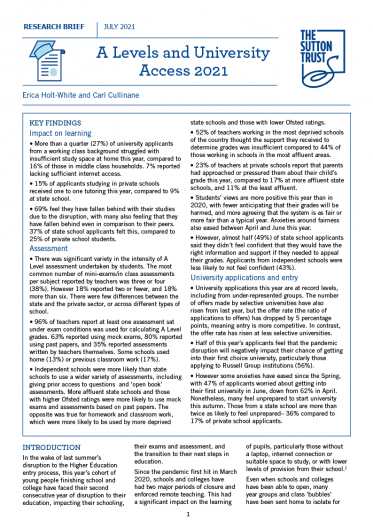Impact on learning
• More than a quarter (27%) of university applicants from a working class background struggled with insufficient study space at home this year, compared to 16% of those in middle class households. 7% reported lacking sufficient internet access.
• 15% of applicants studying in private schools received one to one tutoring this year, compared to 9% at state school.
• 69% feel they have fallen behind with their studies due to the disruption, with many also feeling that they have fallen behind even in comparison to their peers. 37% of state school applicants felt this, compared to 25% of private school students.
Assessment
• There was significant variety in the intensity of A Level assessment undertaken by students. The most common number of mini-exams/in class assessments per subject reported by teachers was three or four (38%). However 18% reported two or fewer, and 18% more than six. There were few differences between the state and the private sector, or across different types of school.
• 96% of teachers report at least one assessment sat under exam conditions was used for calculating A Level grades. 63% reported using mock exams, 80% reported using past papers, and 35% reported assessments written by teachers themselves. Some schools used home (13%) or previous classroom work (17%).
• Independent schools were more likely than state schools to use a wider variety of assessments, including giving prior access to questions and ‘open book’ assessments. More affluent state schools and those with higher Ofsted ratings were more likely to use mock exams and assessments based on past papers. The opposite was true for homework and classroom work, which were more likely to be used by more deprived state schools and those with lower Ofsted ratings.
• 52% of teachers working in the most deprived schools of the country thought the support they received to determine grades was insufficient compared to 44% of those working in schools in the most affluent areas.
• 23% of teachers at private schools report that parents had approached or pressured them about their child’s grade this year, compared to 17% at more affluent state schools, and 11% at the least affluent.
• Students’ views are more positive this year than in 2020, with fewer anticipating that their grades will be harmed, and more agreeing that the system is as fair or more fair than a typical year. Anxieties around fairness also eased between April and June this year.
• However, almost half (49%) of state school applicants said they didn’t feel confident that they would have the right information and support if they needed to appeal their grades. Applicants from independent schools were less likely to not feel confident (43%).
University applications and entry
• University applications this year are at record levels, including from under-represented groups. The number of offers made by selective universities have also risen from last year, but the offer rate (the ratio of applications to offers) has dropped by 5 percentage points, meaning entry is more competitive. In contrast, the offer rate has risen at less selective universities.
• Half of this year’s applicants feel that the pandemic disruption will negatively impact their chance of getting into their first choice university, particularly those applying to Russell Group institutions (56%).
• However some anxieties have eased since the Spring, with 47% of applicants worried about getting into their first university in June, down from 62% in April. Nonetheless, many feel unprepared to start university this autumn. Those from a state school are more than twice as likely to feel unprepared– 36% compared to 17% of private school applicants.
